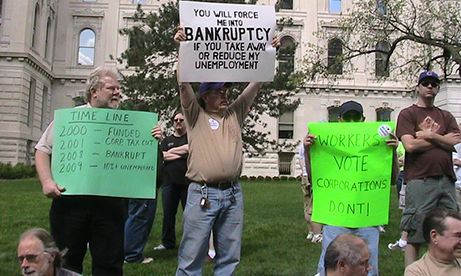
With high unemployment appearing to be a permanent part of the economic picture, the long-term poor are turning to increasingly desperate measures to survive. Many are selling food stamps for cash. Over 6 million people today report food stamps as their only source of income.
In a recent study by Colorlines magazine “Selling Food Stamps for Kids Shoes,” author Seth Wessler says selling food stamps is a growing survival mechanism, and one in which the already poor are being short changed. In a follow-up article for the Huffington Post on the same topic focusing on Hartford, Wessler writes, “they sell their food stamps at the corner bodega for 70 cents on the dollar just to cover basics like utility bills and winter shoes for their kids.”
Hartford has for several years had among the highest poverty and jobless rates in the country.
Across the country, the problem of long-term poverty and unemployment is growing. The New York Times reports, “6.3 million Americans who have been unemployed for six months or longer, the largest number since the government began keeping track in 1948. That is more than double the toll in the next-worst period, in the early 1980s.”
Large numbers of the unemployed are not receiving any benefits, a growing source of public anger. “On average, only two-thirds of unemployed people received state-provided unemployment checks last year, according to the Labor Department. The rest exhausted their benefits, fell short of requirements or did not apply.” Due to welfare reform earlier in the decade, many do not qualify for already restrictive support. “As of 2006, 44 states cut off anyone with a household income totaling 75 percent of the poverty level – then limited to $1,383 a month for a family of three,” writes the Times.
Over 10 million jobs were lost in the last recession. Hopes are dim they will be replaced.
Even establishment economists points to investment goes to the highest rate of profit, not job creation, as the cause. Says the Times, “American business is about maximizing shareholder value,” said Allen Sinai, chief global economist at the research firm Decision Economics. “You basically don’t want workers. You hire less, and you try to find capital equipment to replace them.”
Over 6 million manufacturing jobs have lost since 2000, with 2.3 million disappearing since 2007.
These circumstances have prompted calls for stepped up government job creation measures, beyond the modest measures so far proposed by the House and Senate.
Current legislation, while important, are only a first step and will yield scanty results. An online business website, seekingalpha.com writes, “Moody’s Economy.com estimates that an aggressive jobs program could help create a maximum of 727,000 jobs, while a more modest effort could create up to 250,000 jobs.” In the best circumstances this would amount for 10 percent of the total needed.
Little is expected from tax breaks for small business either. “Think of it this way: If the average worker costs about $50,000 per year in pay and those ever costlier benefits, the tax credit would (temporarily) lower the payroll cost of a new employee by 10 percent. When was the last time a 10 percent discount persuaded you to buy something you wouldn’t have purchased otherwise?”
The AFL-CIO and the Jobs4America now coalition have called for government action to create new jobs funded in part by a revenue stream, such as a financial transactions tax on corporate profits.
Emphasis now is on extending unemployment compensation and COBRA subsidies.








